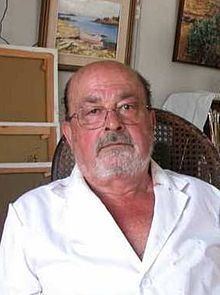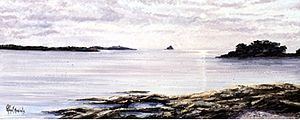Nationality Spanish | Name Jordi i Movement Figurative, Realistic | |
 | ||
Full Name Jordi Pagans i Monsalvatje | ||
Jordi Pagans i Monsalvatje (18 April 1932 – 4 January 2017) was a Catalan and Spanish painter.
Contents

Artistic Tradition
Pagans was born in El Masnou, on 18 April 1932. Son of Alfred Pagans i Llauró and Clara Monsalvatje i Iglèsias, both coming from families of a long and rich artistic tradition which included members such as the guitar player and singer Llorenç Pagans i Julià (1838–83), brother of his grand grandfather, and good friend of Wagner and Edgar Degas' father. In several Degas’ paintings, the chanteur Pagans is portrayed alongside the painter's father.
Also, his grandfather, Francesc Monsalvatje i Fossas (1853–1917), developed important historical studies about the ancient Country of Besalú. Not to forget his uncle Xavier Monsalvatje i Iglèsias (1881–1921), writer and painter, and finally his cousin Xavier Montsalvatge i Bassols (1911–2002), who is considered the most important Catalan composer of his generation.
Artistic career
Jordi Pagans began painting in 1948. In 1950 he studies with Saturo López and assists to night classes in the School of Fine Arts of Barcelona. In 1956 he works in the "atelier" of Josep Roca Sastre, whose teachings and orientation are decisive in his formative years. The paintings of this period show that Pagans was already a master expressing the essentials, using as his own the concepts of impressionist and cubist schools. In 1955, he spends a couple of months in Paris, visiting the Louvre and the Jeu de Paume Museums, walking and taking sketches of the great Parisian avenues and boulevards.
He began exhibiting his work in group shows in 1953. He gains early recognition receiving in 1956 the Royal Circle Artistic Award from the Council of Barcelona and the "Rafael Llimona" Award in 1959, year in which he makes his first solo exhibit in the Municipal Gallery of Girona. In 1961 his work is shown for the first time in the "Club dels Quatre Vents" in Paris. The Ateneu Barcelonés shows his work in January 1962. Since then, his work has been exhibited continuously till the present (currently he is exhibiting in Girona).
In the 60's he keeps a close friendship with painter and historian Rafael Benet i Vancells (1899–1979) whose teachings were decisive. Rafael Benet enjoyed sharing time with young artists and considered Pagans one of his very favourites. The group that gathered at the café-restaurant "El Glaciar" of the Ramblas in Barcelona included Benet, Pagans, Humbert, Prim, Pruna and Alfred Figueres, among others. In 1963 he takes part of the "Realitat Visual" group, whose ideas about painting may be summarised as: painting should be a never-ending state of crisis between intelligence and the sensible as well as between knowledge and the feeling of reality.
Along these years (1963–1965), Jordi Pagans knows the marvellous landscape of Cadaqués, which since that moment captivates him. This small town of the northern Spanish Catalan coast and the sites around it offer the artist a peculiar and structured landscape which reveals itself as a pre-existence of his own dreamed landscape. Already a solid context of masses is characteristic of his paintings, and furthermore, the quiet and broad sense of the figurative and realistic composition, which his work has developed since then.
Artistic Style
In absence of violent contrast and supported by the Mediterranean conception of light and colour it is remarkable in his career the constant maturation of an almost gestual modulation techniques of form and volume based upon brush strokes full of impasto. Pagans i Monsalvatje sees painting as a personal interpretation of the artist but capable of arriving to the onlooker through a never-ending state of crisis between knowledge and the feeling of reality.
Through his career, Jordi Pagans has worked and investigated with different materials to paint his urban and Mediterranean landscapes and still lives. He has arisen not only as an oil painter but also as a drawer, watercolorist, pastel and gouache painter. Not to forget his graphic work done in a great diversity of techniques but fundamentally etchings.
Awards
1956 "Real Círculo Artístico" award, Concourse of new painters, Barcelona council
1959 Young painting award "Rafael Llimona", Sala Parés, Barcelona
1967 Honor diploma "XI Salon de Mayo", Barcelona
1968 Second prize in the painting concourse "Vila de Centelles"
1969 Third position in the Vallès art meeting, Granollers First position in thepainting concourse "Vila de Centelles Second position in the "National" concourse of Amposta
1972 "María Grifé" award, VII Concourse "Vila de Palamós"
1974 "Ministerio de la Vivienda" prize IX Concourse "Vila de Palamós"
1975 "María Trías" award (in memorial), "Vila de Palamós"
1980 "Ciudad de Huesca" diploma, IV Biennal Nacional de Huesca
1982 Special mention (Official diploma), Sala de Avignon, France Honorifical mention in the VIII Biennal of Vilafranca del Penedès
